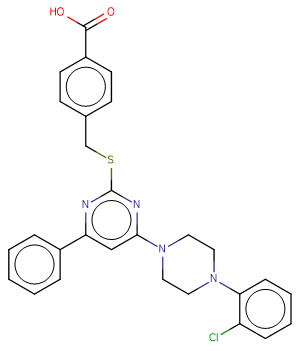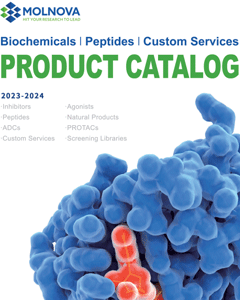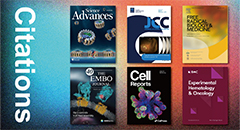
J-14
CAS No. 1043854-13-2
J-14 ( —— )
产品货号. M21559 CAS No. 1043854-13-2
J-14 是一种可逆硫氧还蛋白抑制剂(IC50:8.1 μM)。 J14 通过抑制硫氧还蛋白诱导氧化应激(细胞内 ROS 积累),从而导致细胞毒性和癌细胞死亡。
纯度: >98% (HPLC)
 COA
COA
 Datasheet
Datasheet
 HNMR
HNMR
 HPLC
HPLC
 MSDS
MSDS
 Handing Instructions
Handing Instructions
| 规格 | 价格/人民币 | 库存 | 数量 |
| 2MG | ¥340 | 有现货 |


|
| 5MG | ¥551 | 有现货 |


|
| 10MG | ¥786 | 有现货 |


|
| 25MG | ¥1280 | 有现货 |


|
| 50MG | ¥1960 | 有现货 |


|
| 100MG | ¥3329 | 有现货 |


|
| 200MG | 获取报价 | 有现货 |


|
| 500MG | 获取报价 | 有现货 |


|
| 1G | 获取报价 | 有现货 |


|
生物学信息
-
产品名称J-14
-
注意事项本公司产品仅用于科研实验,不得用于人体或动物的临床与诊断
-
产品简述J-14 是一种可逆硫氧还蛋白抑制剂(IC50:8.1 μM)。 J14 通过抑制硫氧还蛋白诱导氧化应激(细胞内 ROS 积累),从而导致细胞毒性和癌细胞死亡。
-
产品描述J-14 is an inhibitor of reversible sulfiredoxin(IC50 : 8.1 μM).?J14 induces oxidative stress (intracellular ROS accumulation) by inhibiting sulfiredoxin leading to cytotoxicity and cancer cell death.
-
体外实验Cell Viability Assay Cell Line:A549 cells Concentration:0-100 μM Incubation Time:0 hour, 24 hours, 48 hours, 72 hours, 96 hours Result:Inhibited the growth of A549 cells in a concentration- and a time- dependent manner.Western Blot Analysis Cell Line:A549 cells Concentration:20 μM Incubation Time:48 hours, 72 hours Result:Caused not only the release of cytochrome c into the cytosol, but also the activation of caspase-3 and caspase-9.
-
体内实验Animal Model:Six-week-old BALB/c nude female mice injected with A549 cells Dosage:50 mg/kg Administration:Intraperitoneal injection; daily; for 16 days Result:Significantly reduced the growth of human lung tumor without acute toxicity.
-
同义词——
-
通路Others
-
靶点Other Targets
-
受体sulfiredoxin
-
研究领域——
-
适应症——
化学信息
-
CAS Number1043854-13-2
-
分子量517.04
-
分子式C28H25ClN4O2S
-
纯度>98% (HPLC)
-
溶解度DMSO:260 mg/mL (502.86 mM; Need ultrasonic)
-
SMILESOC(=O)c1ccc(CSc2nc(cc(n2)-c2ccccc2)N2CCN(CC2)c2ccccc2Cl)cc1
-
化学全称——
运输与储存
-
储存条件(-20℃)
-
运输条件With Ice Pack
-
稳定性≥ 2 years
参考文献
1.Kim H et al. Sulfiredoxin inhibitor induces preferential death of cancer cells through reactive oxygen species-mediated mitochondrial damage. Free Radic Biol Med. 2016 Feb;91:264-74.
产品手册




关联产品
-
Methyl phenylacetate
Methyl phenylacetate (Methyl 2-phenylacetate) is a RIFM flavor extracted from the outer layer of fermenting mycelium.
-
8-Epiloganin
The fruits of Cornus officinalis Sieb. et Zucc.
-
MSC2504877
MSC2504877 是一种坦科聚合酶抑制剂,可增强临床 CDK4/6 抑制剂的效果。 MSC2504877 抑制 palbociclib 引起的 Cyclin D2 和 Cyclin E2 上调,并增强对磷酸 Rb 的抑制。



 021-51111890
021-51111890 购物车()
购物车()
 sales@molnova.cn
sales@molnova.cn







